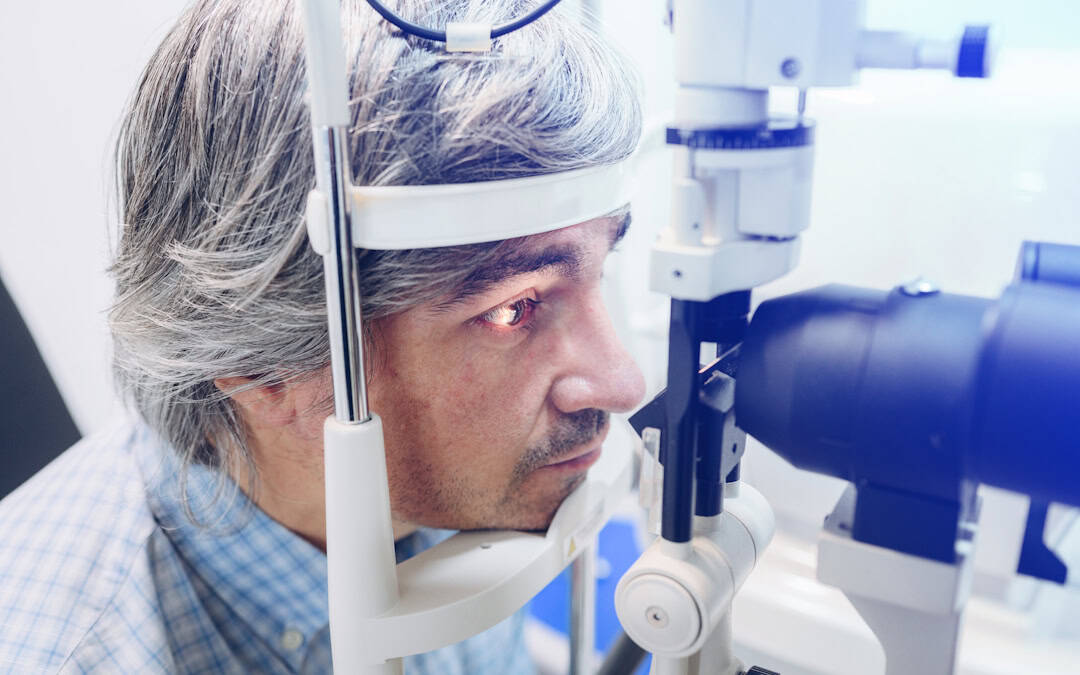Approximately 11 million people in the United States currently live with age-related macular degeneration (AMD). AMD is a leading cause of vision loss in adults over 60. If left untreated, AMD can eventually lead to blindness, making it a serious concern for aging adults.
Certain people face higher risks than others. Women and individuals of Caucasian descent develop AMD more frequently, and anyone with a family history faces significantly higher chances of developing the condition. The disease appears in two distinct forms: dry AMD progresses slowly through your retina, while wet AMD can cause much faster vision loss.
You can protect your vision naturally by taking specific preventive steps.
Your daily choices can make a significant difference in fighting AMD. If you are a smoker, one of the most important steps you can take is by quitting. Adding more leafy greens and omega-3 fatty acids to your meals provides your eyes with vital protective nutrients. Making these adjustments helps shield your macula – the central part of your retina responsible for detailed vision.
Regular eye exams play a crucial role in early detection. Following the American Academy of Ophthalmology’s recommendation for comprehensive eye exams by age 40 and every one to two years after 65 helps catch the earliest signs of AMD before they progress to vision loss. This proactive approach, combined with lifestyle changes, gives you the best chance to maintain healthy vision as you age.
What is Macular Degeneration and Why It Matters
Macular degeneration occurs when the central part of your retina, called the macula, becomes damaged over time. This tiny but crucial area of the eye handles your direct, central vision that lets you see fine details clearly. When the macula deteriorates, you maintain your peripheral (side) vision but lose the ability to see what’s directly in front of you.
Despite being the leading cause of severe vision loss in people 50 and older, macular degeneration doesn’t cause complete blindness. Instead, it creates a challenging visual experience where you might see the outline of a clock but not the hands showing the time. The condition primarily affects daily activities requiring sharp central vision such as reading, driving, recognizing familiar faces, and performing detailed tasks like drawing or sewing.
Age-related macular degeneration (AMD) appears in two distinct forms. Dry AMD makes up about 80% of all cases and typically progresses through three stages:
- Early stage: Changes happen in the macula with no noticeable vision loss
- Intermediate stage: Vision may become blurry or wavy
- Late stage: Central vision deteriorates significantly
Wet AMD is less common but more aggressive, developing when abnormal blood vessels grow underneath the retina. These fragile vessels can leak fluid or blood, causing sudden and severe vision changes. Though wet AMD represents only about 20% of all cases, it’s responsible for 90% of severe vision loss from the disease.
AMD will typically begin affecting one eye before potentially developing in the other, though it can occur in both eyes simultaneously. With early AMD, you may notice little or no impact on your vision initially, making regular eye examinations crucial for early detection.
As AMD progresses, it can profoundly impact your quality of life. Daily activities requiring sharp central vision become increasingly difficult. Advanced AMD can make routine tasks like reading smaller print, cooking, or fixing things around the house particularly challenging. Nevertheless, since AMD doesn’t affect peripheral vision, most people retain their mobility and independence even with significant central vision loss.
Understanding this condition is essential because early intervention, especially with wet AMD, can sometimes help reduce or even recover vision. Without treatment, AMD steadily worsens over time, making prevention and regular monitoring vital steps in protecting your long-term visual health.
7 Doctor-Recommended Ways to Prevent AMD
Medical research has identified several powerful strategies that protect your vision from age-related macular degeneration. These approaches can significantly reduce your risk or slow the progression if you’ve already been diagnosed with AMD. Let’s look at the most effective methods eye doctors recommend.
1. Quit smoking immediately
Smoking stands as the most controllable risk factor for macular degeneration. Current smokers are 2-4 times more likely to develop AMD than non-smokers. Eye damage happens faster too as smokers typically develop AMD up to 10 years earlier and experience faster disease progression with reduced treatment response.
The good news is that quitting helps. Studies have shown that after 20 years of cessation, your risk returns to that of a non-smoker. This makes smoking cessation one of the most important steps you can take to protect your vision.
2. Eat more leafy greens and colorful vegetables
The colors of food in your meals directly impact your eye health. A diet rich in dark leafy greens provides lutein and zeaxanthin—powerful antioxidants that collect in your macula. These “eye vitamins” help protect your vision from free radical damage that contributes to AMD.
Following a Mediterranean diet has been associated with a 26% lower risk of progression to advanced AMD. This approach emphasizes vegetables, fruits, whole grains, fish, and olive oil—all foods that support overall eye health.
3. Take AREDS supplements if recommended
If you have intermediate AMD in one or both eyes, special AREDS2 supplements can slow vision loss by 25%. These contain specific amounts of vitamin C, vitamin E, lutein, zeaxanthin, zinc, and copper.
You can’t get these precise amounts from food or regular multivitamins alone. Talk with your eye doctor about whether these supplements are right for your specific situation before starting them.
4. Wear sunglasses with UV protection
The sun that brightens your day can also damage your eyes over time. Long-term UV exposure contributes to retinal damage.
Always wear sunglasses labeled “UV 400” that block 99-100% of both UVA and UVB rays. Wraparound frame styles will provide additional protection by blocking sunlight from the sides.
If possible, you should also try to limit outdoor activities between 10 a.m. and 4 p.m. when sunlight is strongest.
These simple habits offer significant protection for your macula.
5. Maintain healthy blood pressure and weight
Your cardiovascular health directly affects your eye health. High blood pressure is associated with decreased blood flow to your retina. Regular physical activity (at least 30 minutes daily) helps maintain healthy weight and reduces cardiovascular disease risk.
Some studies have also shown that keeping your blood pressure within recommended guidelines will help ensure your eyes receive proper blood flow and nutrients, which can also help prevent or slow AMD progression.
6. Know your family history and get regular eye exams
Your genes play a significant role in AMD risk. People with a first-degree relative affected by AMD have significantly higher risk. Early detection through regular comprehensive eye exams is essential, especially if AMD runs in your family.
Talk with relatives about their eye health history. This information helps your eye doctor determine how frequently you should be examined and what specific signs to monitor.
7. Use the Amsler Grid to monitor your vision
The Amsler grid is a simple daily test that helps detect early vision changes. Cover one eye, focus on the center dot, and check for wavy lines or blank spots.
When using the Amsler grid, be sure to test each eye separately. Having a “good eye” can compensate for an eye with wet AMD.
The Amsler grid is a simple at-home monitoring tool that can help catch AMD progression early when treatment is most effective.
Call your doctor immediately if you notice changes in your vision.
Understanding Your Risk Factors
Knowing what factors increase your chances of developing macular degeneration helps you take more effective steps to protect your vision. You can control some of these risk elements, while others are simply part of who you are.
Age and gender
Age represents the strongest risk factor (which unfortunately we cannot change). Your chances of developing AMD climb dramatically as you get older, with people aged 60-80 facing three times higher risk than those under 60. The numbers tell a clear story – only about 2% of people in their 50s have AMD, but that jumps to nearly one-third of those over 75.
Gender plays a significant role too. Approximately two-thirds of AMD patients are women. This difference may partly reflect women’s longer life expectancy rather than direct biological factors, but your gender remains an important consideration when assessing your personal risk profile.
Genetics and family history
Your family history significantly impacts your AMD risk. Having a parent with macular degeneration roughly doubles your chances of developing the condition. Scientists have identified over 30 genes that can increase susceptibility, with the complement Factor H and ARMS2/HTRA1 genes creating the greatest impact.
The genetic connection is striking: nearly 74% of people with AMD have variations in either the Factor H or Factor B genes. This makes understanding your family eye health history a crucial step in determining your personal risk level and appropriate prevention strategies.
Smoking and lifestyle habits
Smoking stands as the most influential risk factor you can actually control. If you currently smoke, you face 2-4 times greater AMD risk and will typically develop the condition 5-10 years earlier than non-smokers.
The damage occurs because cigarette smoke contains oxidants that harm your retina when absorbed through your lungs. While both former and current smokers have elevated risk, quitting can still significantly decrease your chances of vision loss. This represents one of the most powerful steps you can take to protect your sight.
Race and ethnicity
Your ethnic background also affects your risk for developing AMD. White people experience the highest rates (5.3-5.4%), followed by Chinese and Asian Americans (4.5-5.0%), Hispanics (3.3-3.8%). Studies have shown that black people have the lowest prevalence of AMD with about 70% lower risk than whites.
These differences persist even after adjusting for factors like smoking, blood pressure, and diabetes, suggesting genetic or biological mechanisms at work. Understanding where you fall on this spectrum helps you and your eye doctor create the most appropriate monitoring and prevention plan for your specific needs.
How to Prevent Macular Degeneration Naturally
You can also make specific lifestyle adjustments to reduce your risk of macular degeneration naturally without medication or invasive procedures. These natural approaches work by targeting the root causes of macular damage while supporting your overall eye health.
Focus on a nutrient-rich diet
Certain nutrients specifically protect your macula. Lutein and zeaxanthin—often called “eye vitamins”—accumulate in your macula and shield it from damage. These powerful carotenoids act as natural defenders against harmful light and oxidative stress. These nutrients are abundant in dark leafy greens like kale, spinach, and collard greens, along with yellow fruits and vegetables.
Omega-3 fatty acids play a crucial role in reducing eye inflammation and supporting visual cell structure. Your retina needs these essential fats to maintain healthy function. Include oily fish (salmon, mackerel, anchovies, trout) in your meals 2-3 times weekly. For additional protection, incorporate:
- Foods rich in vitamin C: citrus fruits, bell peppers, strawberries
- Vitamin E sources: nuts, avocados, sunflower seeds
- Low glycemic index foods: whole grains, legumes, most fruits and vegetables
Maintain regular physical activity
Regular physical activity or exercise directly affects macular degeneration onset and progression. Research from the University of Virginia School of Medicine found that exercise reduced harmful blood vessel overgrowth in the eyes by up to 45%.
The good news is that you don’t need intense workouts to protect your vision. Activities like walking, swimming, or cycling three times weekly can make a significant difference. Water exercises are especially beneficial for older adults as they’re gentler on joints while still providing eye protection benefits.
Reduce screen time and eye strain
Approximately 80% of American adults use digital devices more than two hours daily, yet many don’t realize the impact on their eyes. Nearly 67% use multiple devices simultaneously, creating even more strain.
Digital eye strain happens primarily because we blink less when staring at screens. To protect your vision throughout the day:
- Follow the 20-20-20 rule: Every 20 minutes, look at something 20 feet away for 20 seconds
- Adjust your screen settings to reduce brightness and glare
- Consider blue light filters for your devices
- Position screens 25 inches (arm’s length) away with your gaze slightly downward
Making these natural adjustments part of your daily routine gives your eyes their best chance against macular degeneration. You can read more tips about reducing digital eye strain in our recent guide, How to Protect Your Eyes During Your Daily Screen Time.
While these changes might seem small, their cumulative effect on your long-term vision health can be substantial.
Expert Eye Care in Pittsburgh for AMD at Chang Eye Group
Age-related macular degeneration threatens your vision as you age, but you have multiple ways to protect your eyesight. Throughout this guide, we’ve looked at practical steps you can take to reduce your AMD risk.
Early detection makes the greatest difference in preserving your vision. If you have a family history of AMD or notice any visual changes, it’s important to schedule a comprehensive eye exam. Regular screenings help doctors identify early signs of AMD before significant vision loss occurs.
Prevention works best when approached from multiple angles. Rather than focusing on a single strategy, combining nutritional improvements, regular physical activity, UV protection, and routine eye exams provides your strongest defense against this common cause of vision loss.
Your eyes deserve complete protection. Schedule an appointment with an ophthalmologist in Pittsburgh at Chang Eye Group today to safeguard your vision for the future.







